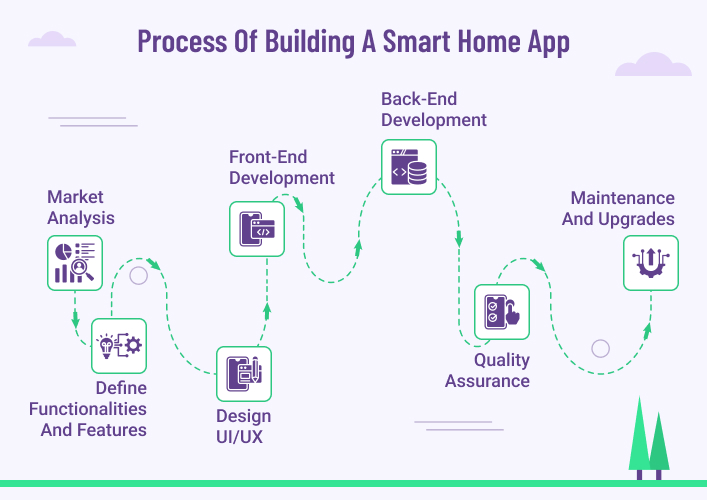Process Of Building A Smart Home App
There are several important stages in creating a functional and helpful smart home app. Let’s have a look at them:
It is necessary to carry out extensive market research. The results of this research help you identify the competitors, as well as current smart home applications, and the benefits and drawbacks of using each one. Researching the pricing techniques, user experiences, and customer feedback used by competitors may teach you how to set your app apart from the competition and give a unique value. This can be accomplished by studying the apps’ respective marketplaces.
Define Functionalities and Features
It is necessary to initially make a decision about the app’s features and functions before beginning the development of a smart home automation app. This involves selecting the functionality that the application will provide, such as the ability to manage smart devices, develop automation standards, or keep checks on energy use. Furthermore, it is also vital to have a solid understanding of the specific requirements and preferences of the target audience in order to develop the app correctly.
Creating applications for smart homes involves careful design, beginning with the development of the user interface and the user experience. It is essential to have a user interface that is both appealing and easy to use in order to increase customer satisfaction. By developing wireframes, mockups, or prototypes, you may get an idea of how the app’s structure, navigational flow, and component placement will look.
When it comes to providing a fluid experience for our users, the frontend components of our app are really essential. In order to accomplish this goal, developers of smart home apps place a high priority on building code using the right coding languages and frameworks. The development team guarantees that your app has a wonderful appearance and faultless functionality by carrying out these steps.
It is important to set up the needed servers, databases, and application programming interfaces (APIs) for data administration and communication. Following the completion of the UI development phase, the construction of the app’s backend architecture begins. A safe and scalable backend design is used in the app to handle interactions between users, store data, and interact with a variety of smart home systems and devices. This ensures that the app is able to do all of these things.
Testing and debugging are critical activities that have a significant impact on the dependability and performance of the software. Extensive testing is carried out in order to locate and correct any bugs, faults, or inconsistencies that may be present in the program. In order to ensure that users have a uniform experience across all devices must be performed. Furthermore, make sure that all features and functions work as they were designed to.
After the launch of the app, regular updates are released to resolve a variety of issues. Providing outstanding customer service and responding quickly and effectively to any concerns or questions raised by users are essential to preserving a positive user experience. If the app is kept up to date with the latest technology advances and consumer preferences, it will work in the ever-evolving ecosystem of smart homes in the best possible way.
Conclusion
In order to construct a smart home app, the following steps need to be taken: defining the aim of the app, doing market research, designing the user interface, developing the backend of the app, integrating smart home devices, automating and intelligently controlling the app, conducting rigorous testing, and releasing the app in progressive steps. Using these fundamentals, you may create a successful app in the rapidly growing smart home sector.
How much does it cost to develop a smart home automation app?
Numerous variables affect the final cost of a smart home app, such as its complexity, target platform(s), set of features, length of development time, and location of the team. But, it can approximately range from $12,000 to $50,000 or more.
How long does it take to develop a smart home automation app?
Building a fully functional smart home software might take up to six months. All phases of the project, from conception to final rollout, fall within this time frame. However, more complex applications might take much longer, anywhere from six months to a year or more.
How to develop a smart home app at a low cost?
You can build the app at a low cost by hiring skilled app developers from India.
What features should a smart home app have?
A smart home app should have features or functionalities like smart lighting, AI-controlled entertainment, and connection with assistants like Google or Alexa, etc.
On which platform should the app be built?
You can build on cross-platform or native. It completely depends on your target audience, budget, and tech developers.
